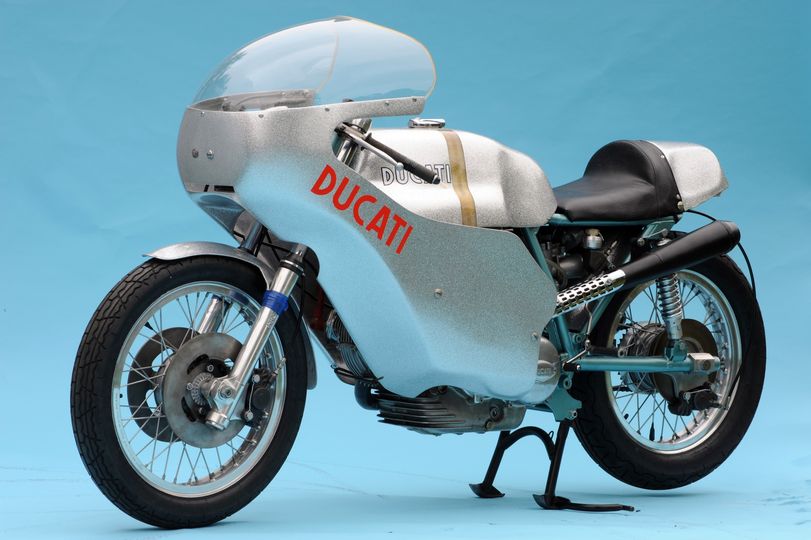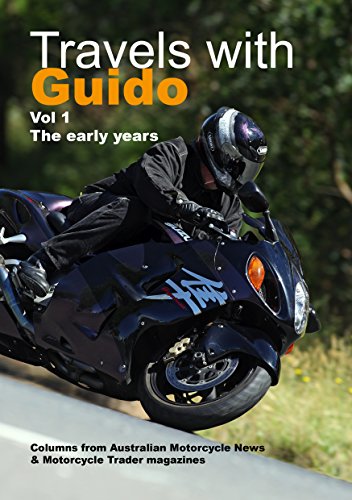Motorcycle Investor mag
Subscribe to our free email news
Imola Ducatis
(by Ian Falloon, Mar 2022)

The
machines that really put Ducati on the performance map
April 23, 1972, was
the day when a brace of specially prepared desmodromic
750 racers took on the
best the world’s manufacturers had to offer, and
trounced them convincingly. It
was the inaugural Imola 200, the “Daytona of Europe”,
for Formula 750 machines,
racing 750cc machines with production-based motors.
The win at Imola
marked the transition for Ducati, from a relatively
small and unknown Italian
manufacturer, primarily of small capacity single
cylinder bikes, to that of a
marque equal to any other. Within Italy, and to certain
cognoscenti in other
countries, Taglioni and Ducati were respected for
technical excellence and
innovation. Yet, in production terms, Ducati was a minor
manufacturer of
motorcycles. Imola changed that.
The impetus for developing
a racing 750 had occurred back in July 1971. In a
one-off ride, Mike Hailwood
was to pilot a prototype Formula 750 machine at
Silverstone in August 1971.
However, although Hailwood tested the bike, and recorded
a sixth fastest
practice lap for the F750 race, he elected not to race
it. Hailwood told Motor
Cycle magazine, “It did not handle well enough.
This isn’t surprising
because it is only three weeks old and has never been
raced before; it just
needs a bit of sorting out. It should be good then”.
With the support of
Fredmano Spairani, Fabio Taglioni was given the brief to
make an all-out
assault on this important race. It was being heavily
promoted, and nine
different factories had entered works supported teams.
In order to assess the
level of competition,
Taglioni made the trip
to Daytona in March 1972, and came away impressed by the
well-developed
Japanese racers. He realised that he couldn’t tackle
them head on, he didn’t
have the resources. Utilising proven technology from the
350 Desmo and 500
racers, he aimed to build a balanced machine, with
handling and braking matched
to useable horsepower.
Upon his return from
Daytona, serious work began on developing the Imola
bikes. Surprisingly,
Taglioni started with standard 750GT street bikes. They
had 750 engine numbers,
indicating that bikes were just taken off the production
line and into the
racing department. The frames still had centre-stand
mounts and stock frames.
They also had machined
production leading axle Marzocchi forks, but there was
more to these bikes than
met the eye. The engines used desmodromic valve control
enabling the engine to
run to 9200rpm. These were the first bikes to use the
“Imola” desmodromic
camshafts. Power of 84bhp at 8800 rpm was claimed at the
rear wheel, but more
importantly it was the spread of power that was so
advantageous.
At 7000 rpm the engine
was said to make 70bhp. Compression was up to 10:1 and
these engines still used
the wide, 80 degree included valve angle. They also used
the first versions of
the new 40mm Dell’Orto PHM concentric carburettor.
In order to keep
combustion temperatures down, an oil cooling system was
fitted that treated the
oil to the cylinder heads, and dual-plug ignition
installed with an additional
10mm Lodge spark plug. This enabled ignition advance to
be cut back to 34
degrees before top dead centre.
With the alternator
removed from the right side of the crankshaft, total
loss battery and coil
ignition, still by dual points, was employed. Since his
experience with
electronic ignition on the 500, Fabio Taglioni was wary
of employing it on the
750 for Imola, and was also worried about heat build-up
inside the fairing over
such a long race. Thus the condensers were mounted on
the front frame
down-tubes, away from the heat of the engine.
Further weight was saved
by completely removing the kickstart mechanism, also
increasing ground
clearance on the right side. Braking was uprated to two
Lockheed front discs,
and a rear 230mm disc replacing the road bike’s drum.
With only left side
calipers in stock from the street bikes, these were used
all round, the right
side front having an unusually long brake hose.
A high rise exhaust
pipe was on the left, but not on the right. Imola had
predominantly left hand
corners, but ground clearance was still a problem
because racing tyres required
an 18 inch front wheel instead of a 19 inch. Total dry
weight of these racers
was 392lb (178kg), and they were reputed to pull the
tallest available gearing,
giving 169mph (272km/h).
Ducati approached
Jarno Saarinen, Renzo Pasolini, and then in February,
Barry Sheene. All had
declined, not feeling that the Ducati would be
competitive. Ducati already had
the evergreen 39-year-old Bruno Spaggiari who had raced
every factory bike
since the 1950s, and who knew the Imola circuit
intimately.
To partner Spaggiari
would be the younger Ermanno Giuliano who had raced the
500 Ducati throughout
1971, and to fill the third berth, English rider Alan
Dunscombe. The latter had
already been racing a modified 750GT for English
importer Vic Camp.
Spairani now only
required a top line F750 racer to ride the last bike
and, through Vic Camp,
managed to secure Paul Smart at the last minute.
Originally planning to ride a
Triumph Triple, the deal fell through, and reluctantly
Smart flew to Italy.
While a 750 Desmo with
Sport bodywork had been tested at Modena in March, with
further tests by
Spaggiari with revised bodywork on April 6, it wasn’t
until the April 19 that
the Imola racers were started up for the first time at
Modena. Too late to
correct any defects, Taglioni was quietly confident.
Smart had equalled
Agostini’s lap record, set on a 500cc MV Agusta Grand
Prix bike. In their
specially constructed glass-sided transporter, all seven
Ducatis were
transported the 40km (25 miles) to Imola. Two each for
Smart and Spaggiari, one
for Discombe and Giuliano, and one spare.
On race day, 70,000
spectators crammed into Autodromo Dino Ferrari at Imola.
With works machines in
abundance from MV Agusta, Honda, Norton, Moto Guzzi,
Triumph and BSA, alongside
works supported Kawasaki, Laverda, Suzuki and BMW, they
had hopefully come to
see the Italian factories beat the Japanese teams that
had dominated Daytona.
The best riders in the
world were there too. Giacomo Agostini, Phil Read,
Roberto Gallina, Walter
Villa, Ray Pickrell, Tony Jeffries, John Cooper, Percy
Tait, Ron Grant and
Daytona winner, Don Emde.
In practice,
Spaggiari, followed by Smart, had set the fastest time.
Imola with its fast
sweeping curves, some smooth, others bumpy, and its up
and down topography
seemed to suit the Ducatis. Unlike Daytona this was no
mere horsepower circuit.
This was Imola before the advent of chicanes, a fast
European circuit in the
traditional style.
Agostini, on a
specially prepared 750 MV led the start. This MV, while
still with the
shaft-drive of the road bikes, had a Grand Prix style
frame with 500GP forks
and brakes. At the end of the fourth lap Smart overtook
Agostini, followed a
lap later Spaggiari. From then-on the two Ducatis were
untroubled out in front
and in the final five laps they were both racing for the
lead.
Spaggiari nipped in
front, but on the final lap his bike started to misfire
as he was low on fuel.
He ran wide on a sweeper, allowing Smart to take a
comfortable victory. It had
been a great day for Ducati.
It wasn’t so bad for
Paul Smart either, as he took home 7,080,000 Lire in
prize money. Spairani was
so excited that he donated the winning bike to Smart.
The race speed over
200 miles had been an astonishing 97.76mph (157.35km/h),
with the fastest lap
of 100.1mph (161.11km/h) being shared equally by Smart,
Spaggiari, and
Agostini. It was the start of the modern Ducati legend.
-------------------------------------------------
Produced by AllMoto abn 61 400 694 722
Privacy: we do not collect cookies or any other data.

Archives
Contact





